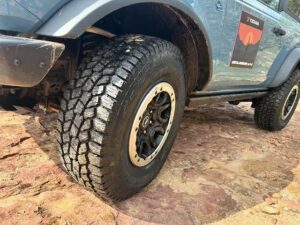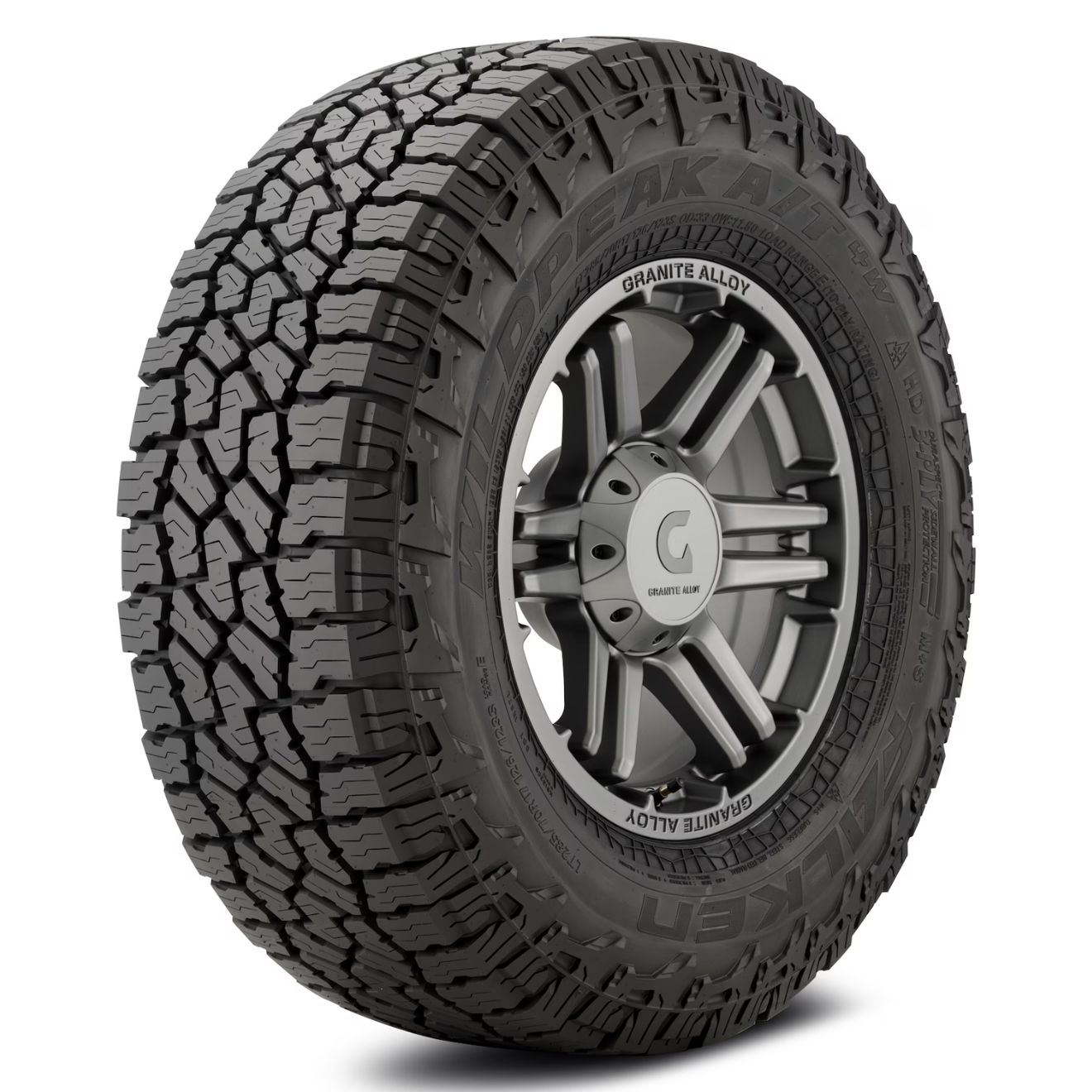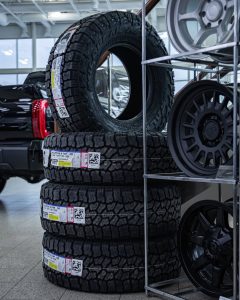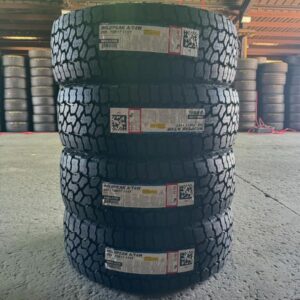Real-world test data, driver impressions, and use-case insights — from a former Bridgestone test engineer.
The Yokohama Geolandar AT4 is Yokohama’s newest On-Road A/T tire, built for commuters in rainy and freeze-thaw regions who need wet-road safety, slush confidence, and quiet daily comfort. The Toyo Open Country AT3, by contrast, sits in the Off-Road A/T category — a sharper, more versatile design with stronger dry grip, balanced stability, and dependable tread life. Both are popular across the US and Canada for light trucks and SUVs, and both are available with the 3PMSF rating for severe winter traction.
That’s the split most buyers face — Geolandar AT4 for wet-weather commuting and year-round refinement vs Toyo AT3 for sharper handling and broader off-road ability. In the sections ahead, I’ll compare them across dry, wet, snow, and off-road testing. You can also line them up in our All-Terrain Tire Decision Tool for quick recommendations tailored by SUV, CUV, or truck class.
Quick Look
The Toyo Open Country A/T III stands out as the sportier all-terrain, posting a 131.5-ft dry stop with 0.78 g cornering. It feels sharper on pavement, with reinforced shoulders and staggered tread blocks that resist flex, giving it a road-tire-like edge in corners. Off-road, it’s equally confident, with balanced scores across dirt, sand, mud, and rock, making it a reliable weekend trail partner. Owners consistently praise its snow traction and trail composure, though it rides firmer and hums more than highway-leaning competitors.
The Yokohama Geolandar A/T4, by contrast, is the commuter’s calm companion. With a 139-ft dry stop at 0.70 g, it trades bite for smooth predictability on long highway runs. Its wet braking (177 ft / 0.47 g) actually outpaces the Toyo, and comfort is its trump card, scoring 8.5/10 for quiet, cushioned ride quality. Drivers rave about its hushed manners at speed and stable feel in rain, though it lacks the trail toughness of the Toyo and struggles in deeper snow or ice compared to sharper, more aggressive A/Ts.
👉 Bottom line: Toyo AT3 = sporty, trail-ready grip; Geolandar A/T4 = quiet commuter refinement.
Toyo Open Country A/T III

Yokohama Geolandar A/T4
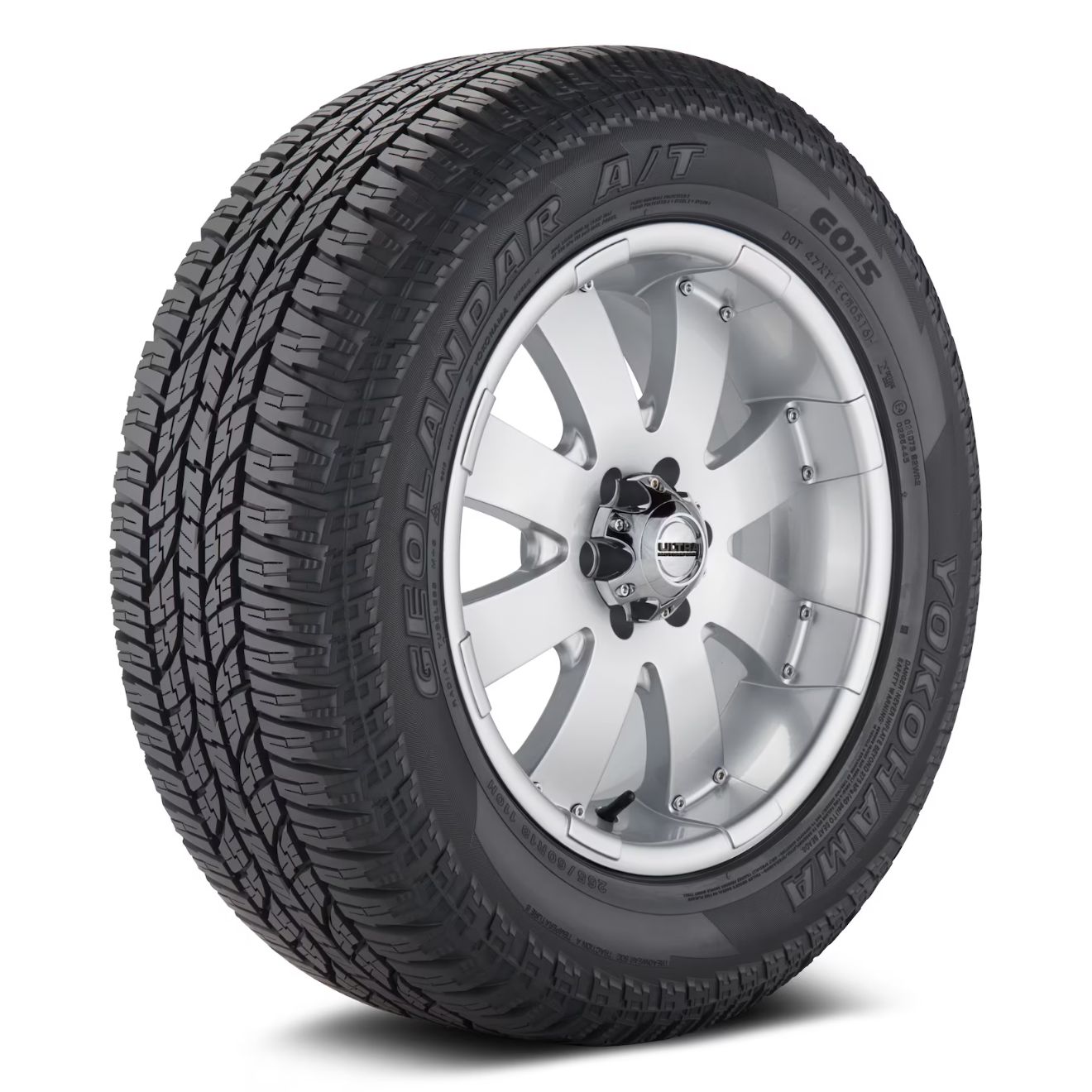
Tire Decision Tool
For those in a hurry: this tool makes it easy. Just pick your vehicle and what matters most to you, and it’ll instantly suggest the best tire options.
Raw Test Data
Tire Test Data
Pick categories to show metrics, then open ☰ to pick tires. Optional chart is hidden by default.
Dry Performance — Toyo sharper, Yokohama steadier at pace
On pavement, Toyo stops in 131.5 ft with 0.78 g cornering, while Yokohama needs 139 ft with 0.70 g. That gap shows in how they drive. Toyo feels sharper and closer to a sport-leaning A/T, while Yokohama takes longer to settle into a turn but cruises smoothly once in line.
Drivers echo the split. A Toyo owner on a Tacoma noted it “felt like a road tire in the corners,” while Geolandar drivers often say it “stays composed and calm, never twitchy.” From my test seat, Toyo’s reinforced shoulders and staggered tread edges keep blocks from flexing, while Yokohama’s softer compound and rib focus lean toward a calmer, less aggressive feel.
SUVs & crossovers: Yokohama feels more natural day-to-day.
½-ton trucks: Toyo gives the sharper edge, Yokohama better for longer drives.
¾-ton & HD: Toyo steadier when loaded; Yokohama less locked-in with weight.
👉 Verdict: Toyo delivers sharper dry response; Yokohama steadies out at speed but lacks bite.
In the rain, Yokohama posts 177 ft / 0.47 g, while Toyo runs longer at 185 ft / 0.50 g. On paper, Toyo shows higher traction, but in practice, Yokohama feels safer because its grooves clear water consistently, keeping stability under control. Toyo grips harder once loaded, but its stopping distance stretches out.
Community feedback makes sense here: Geolandar owners praise it as “confident in the rain, even when worn,” while Toyo drivers say they “need a little more space when roads get greasy.” The explanation lies in balance: Yokohama’s groove layout maintains evacuation across tread life, while Toyo’s harder carcass fights squirm but gives up some raw stopping distance.
SUVs & crossovers: Yokohama inspires more confidence.
½-ton trucks: Close call, but Toyo steadies better with a trailer.
¾-ton & HD: Toyo more predictable under weight, Yokohama lighter rigs only.
👉 Verdict: Yokohama safer for lighter vehicles in heavy rain; Toyo steadier under towing, but needs margin.
Note from the Expert: When it comes to rain, I always emphasize two things: compound grip and water evacuation. You can see the full details in my analysis, but if you take just one thing away, remember that an AT tire’s stiff nature makes achieving top-tier wet performance a constant battle. This is why the question, Are All-Terrain Tires Good in Rain?, requires a nuanced answer that balances tread design against rubber stiffness.
Winter & Snow — Toyo digs better, Yokohama plays it safe
In snow, Toyo stops at 74 ft and launches in 44.0 ft, compared to Yokohama’s 72.0 ft stop and 47.0 ft launch. That means Yokohama brakes shorter, but Toyo pulls away quicker. In real life, Toyo feels more confident in deeper, unpacked snow thanks to its staggered shoulders, while Yokohama is calmer on salted and plowed lanes.
On Jeep forums, Toyo drivers call it “a real snow tire in disguise.” By contrast, Geolandar users often note “it’s safe and easy in winter, but not aggressive.” The design explains it: Toyo has dense siping and compound tuning to stay pliable, while Yokohama keeps rubber firmer, trading off deep-snow bite for stability on cleared roads.
SUVs & crossovers: Yokohama feels steadier on plowed commutes.
½-ton trucks: Toyo wins when fresh snow piles up.
¾-ton & HD: Toyo stronger under weight, Yokohama too muted for heavy snow use.
👉 Verdict: Toyo the better deep-snow performer, Yokohama calmer on plowed lanes.
Note from the Expert: Our discussions often boil down to the core tradeoff. On one hand, you must understand why all-terrain tires are truly effective in deep snow, but not on ice. On the other hand, you face the 3PMSF Paradox—the hidden cost of that badge. The short answer is: The 3PMSF badge certifies traction, but it costs you durability. Dive into our full analysis on the critical 3PMSF rating for severe winter and off-road service, and its hidden costs, before you risk your rig on the trail.
Ice — Neither shines, but Toyo forgives more
Ice is where both tires admit their limits. Toyo stops in 50 ft, while Yokohama stretches to 53 ft. The gap is noticeable — Toyo slides but gives you time to correct, Yokohama feels like it fades away more suddenly.
Drivers say it clearly: one AT3 user admitted it’s “fine if you’re careful, but not a studded alternative.” Yokohama owners echo: “not scary, but not a true ice tire.” The tech shows why: Toyo’s micro-siping keeps a touch of grip, while Yokohama’s harder shoulder compound limits edge effect on glassy ice.
SUVs & crossovers: Both demand caution, Toyo a hair safer.
½-ton trucks: Toyo better for recovery time on ice.
¾-ton & HD: Neither ideal, but Toyo steadier under load.
👉 Verdict: Toyo edges ahead, but neither is a go-to ice solution.
Off-Road — Toyo more capable, Yokohama built for gravel

Off-road scores make the split clear. Toyo posts 7.8 dirt / 7.7 sand / 7.9 mud / 7.8 rock, while Yokohama trails at 6.0 / 5.8 / 5.5 / 5.5. That translates exactly as it sounds: Toyo can tackle mixed trails confidently, while Yokohama is more of a gravel/back-road partner.
Owners say it too. AT3 users mention it “grabs in ruts and never feels soft.” Geolandar drivers tend to frame it differently: “no rock crawling here, just quiet on gravel, and that’s fine.” From my engineering seat, Toyo’s tie-bars and reinforced casing keep blocks stiff under torque, while Yokohama’s lighter ribs reduce harshness but give up trail aggression.
SUVs & crossovers: Yokohama is the highway-friendly choice, Toyo for trail weekends.
½-ton trucks: Toyo a solid compromise between comfort and off-road grip.
¾-ton & HD: Toyo holds together on rocks and mud; Yokohama underbuilt for punishment.
👉 Verdict: Toyo dominates off-road; Yokohama sticks to gravel and light dirt.
Note from the Expert: Every successful day on the trail is about preparation and physics, because tire longevity is earned, not given. Before you even start, you must master the critical link between tire pressure and load range for every rig to maximize your contact patch. Once moving, remember your ultimate off-road armor is your sidewall protection against the inevitable pinch flat. And finally, your traction on the obstacle is dictated by choosing the right aggressive vs hybrid tread pattern for your terrain. Master those three steps, and your rig will be ready for anything.
Here’s where Yokohama claws back ground. It scores 8.5 comfort, compared to Toyo’s 8.0. The difference is clear on long highway runs — Yokohama is quieter and smoother, Toyo a touch firmer and hums as tread wears.
Forum voices back it up: Geolandar drivers rave “dead quiet even at 75 mph,” while Toyo owners admit “a little hum on the freeway, but nothing crazy.” The explanation: Yokohama’s rib-style tread smooths resonance and cushions vibrations, while Toyo’s larger lugs transmit more feedback into the cabin.
SUVs & crossovers: Yokohama wins daily comfort.
½-ton trucks: Both livable, Yokohama quieter.
¾-ton & HD: Noise blends into load anyway, but Toyo firmer.
👉 Verdict: Yokohama is the comfort pick; Toyo is firmer but acceptable.
Note from the Expert: For years, choosing all-terrain meant accepting noise—a true compromise for off-road grip. That’s why the question, Are All-Terrain Tires Louder than Highway Tires?, used to have a simple “yes” answer. Now, with the rise of on-road models, the core issue has shifted from noise to overall refinement. To fully understand which side of the comfort spectrum you’re buying into, you need to determine Are All-Terrain Tires Good for Daily Driving?—a question that depends entirely on the tire’s construction, not just the name.
Where They Fit Best
Yokohama Geolandar A/T4: Best fit for commuters who want a quiet, comfortable highway tire with light snow security and occasional gravel-road manners. Perfect for Southern states, interstate drivers, and SUVs that don’t need serious off-road chops.
Toyo Open Country A/T III*: Suited for those balancing daily use with regular trail runs and winter conditions. Stronger in deep snow and dirt, with sharper dry handling. Ideal for mountain states, snow-belt commuters, and half-ton to ¾-ton trucks.
👉 Bottom line: Yokohama is the commuter’s friend, smooth and quiet with light utility. Toyo is the more versatile all-rounder, sharper on-road and far more capable off it.
Tire Size Selection: The Basics You Can’t Skip
Even the best tread design can’t rescue a tire that’s built too weak. Back when I was testing tires at Bridgestone, I saw all-terrain models that should’ve performed but fell short — simply because the basics (size, load strength, and speed rating) weren’t matched to the vehicle.
P-Metric vs. LT (Light Truck) Tires
The first step is knowing whether you need LT or passenger tires. LT (Light Truck) tires are built with extra reinforcement and stiff sidewalls, designed for towing, hauling, or off-road use. Passenger (P-metric) tires are lighter, smoother, and tuned for daily comfort and fuel efficiency — but they’ll flex more under load.
Understanding Tire Load Range: XL vs. E-Load
Then comes the tire load index and load range — essentially your tire’s strength rating. Here’s where things split between passenger XL and LT E:
XL (Extra Load) is a passenger tire with reinforced sidewalls. It can handle a bit more pressure (~41 PSI) than a standard SL tire and is perfect for SUVs, crossovers, or light trucks that carry extra gear, passengers, or small trailers. XL tires ride softer and quieter than LT options, making them ideal for daily use.
E Load Range is an LT tire class built with a much thicker casing. E-rated tires can handle far more pressure (up to ~80 PSI) and heavier loads, which makes them essential for ¾-ton and 1-ton trucks towing trailers or hauling close to max capacity. The trade-off is weight, stiffer ride, more road noise, and a small drop in fuel efficiency.
Put simply: XL is for “extra luggage and family,” while E is for “truck bed full of bricks or a car trailer.”
Why the Tire Speed Rating Matters for Safety
Finally, don’t overlook the tire speed rating. It’s not just about top speed — it measures how well a tire handles heat and stress at highway pace. Lower ratings (like S) tend to ride softer and last longer, while higher ratings (H, T) feel more stable and responsive under sharp maneuvers. Heat build-up is the silent killer of tires, and speed rating is your safeguard.
Bottom line: Match your tire’s construction (LT vs P-metric), load range (XL vs E), and speed rating to your vehicle’s demands. Get those right, and everything else — off-road grip, winter traction, comfort — will finally perform the way it was designed to.
Final Verdict
If you value sharper steering, stronger snow bite, and true trail capability, the Toyo A/T III is the clear choice. It’s ideal for snow-belt drivers, mountain-state commuters, and half-ton or ¾-ton truck owners who split time between highways and dirt.
If comfort, quiet, and predictable wet-road stability matter most, the Yokohama Geolandar A/T4 is the better fit. It shines in Southern and suburban regions where winters are lighter, highways dominate, and off-road use is limited to gravel or mild dirt.
👉 Bottom line: Toyo is the versatile athlete for year-round adventure, while Yokohama is the calm, commuter-friendly pick for daily drives.
Frequently Asked Questions: Toyo Open Country A/T III vs Yokohama Geolandar A/T4
Which tire has better dry grip?
The Toyo A/T III, with a 131.5-ft stop and 0.78 g cornering, feels sharper and sportier than the Yokohama’s 139 ft / 0.70 g result.Which tire is safer in wet conditions?
The Yokohama Geolandar A/T4 stops shorter in rain (177 ft / 0.47 g), while Toyo requires more distance but steadies better when towing.Which tire performs better in snow?
Toyo digs harder with a quicker launch in deeper snow, while Yokohama feels steadier on salted or plowed commutes.Which tire is safer on ice?
Toyo stops shorter at 50 ft and gives drivers more recovery time, while Yokohama trails at 53 ft and feels less forgiving.Which tire is stronger off-road?
The Toyo A/T III posts stronger scores across dirt, sand, mud, and rock, while Yokohama is more suited to gravel and back roads.Which tire is quieter on the highway?
Yokohama wins with an 8.5 comfort score, running quieter and smoother than Toyo’s firmer 8.0 ride.Who should choose the Toyo A/T III?
Drivers in snow-belt states or mountain regions, and truck owners who want a sharper, more versatile A/T with real off-road ability.Who should choose the Yokohama Geolandar A/T4?
Commuters in Southern or suburban areas who want a quiet, comfortable tire for daily use with light winter and gravel-road security.
